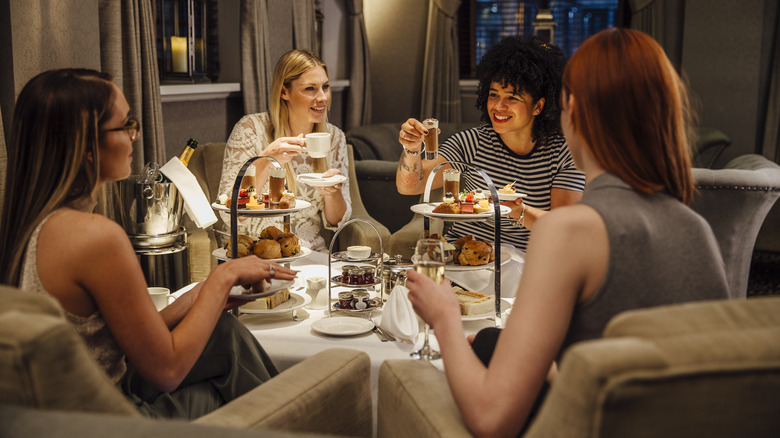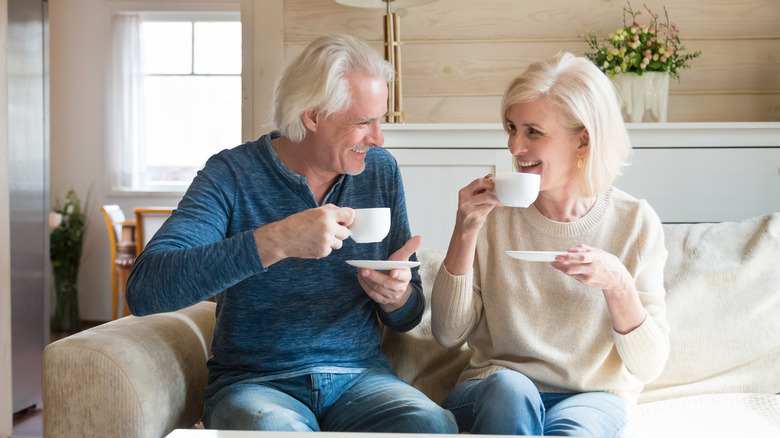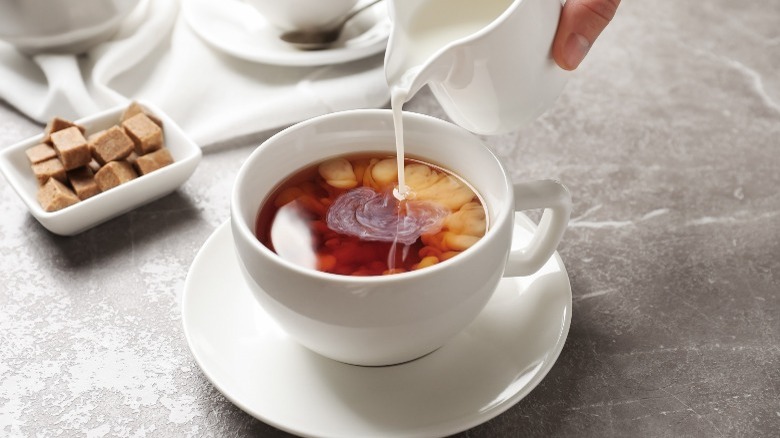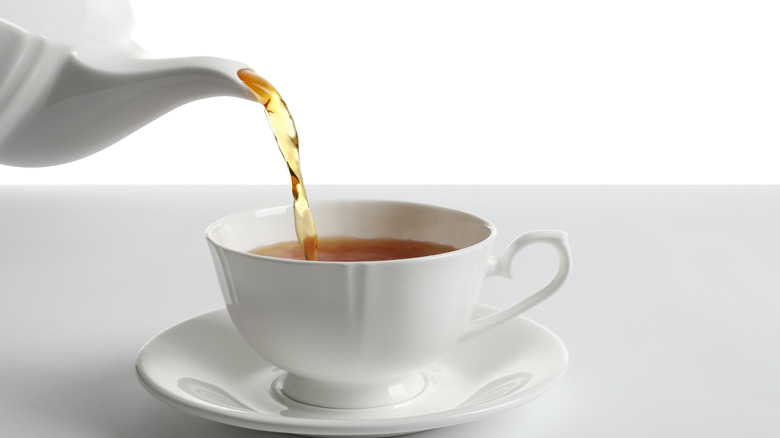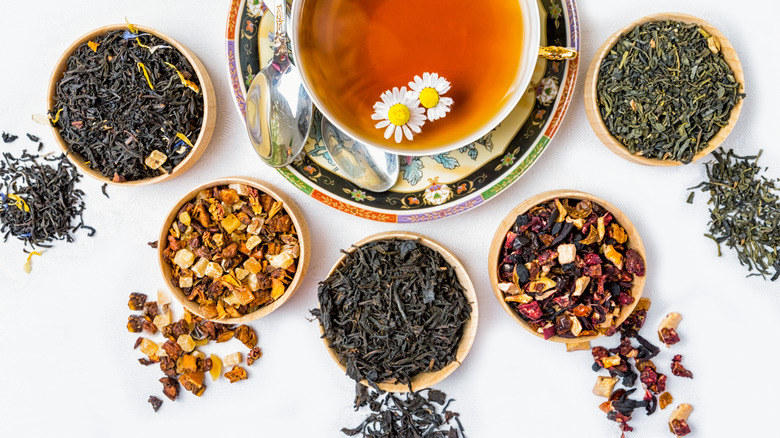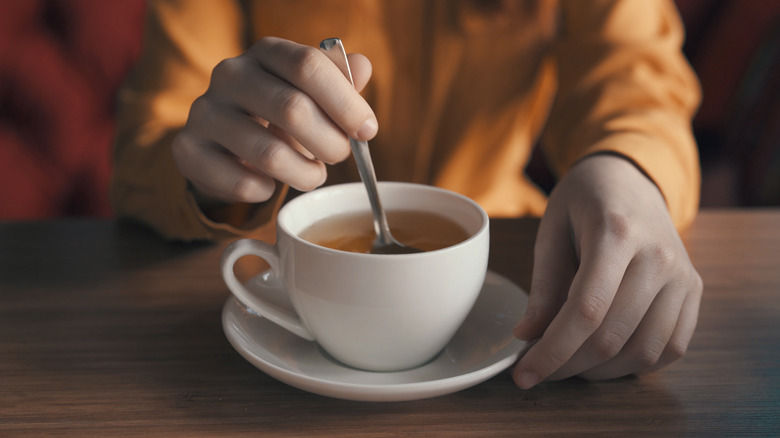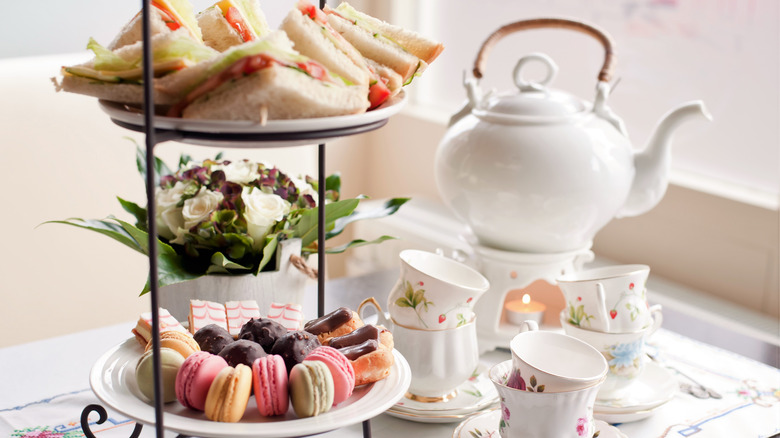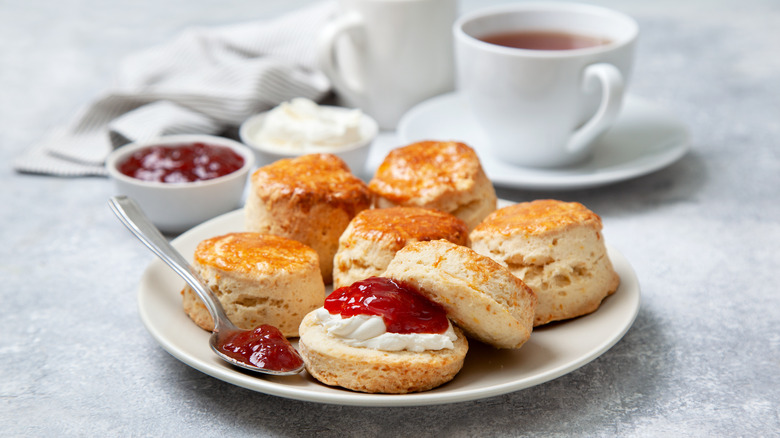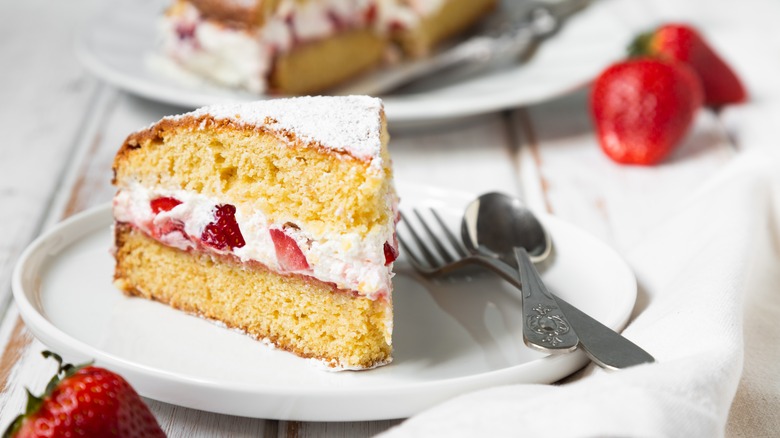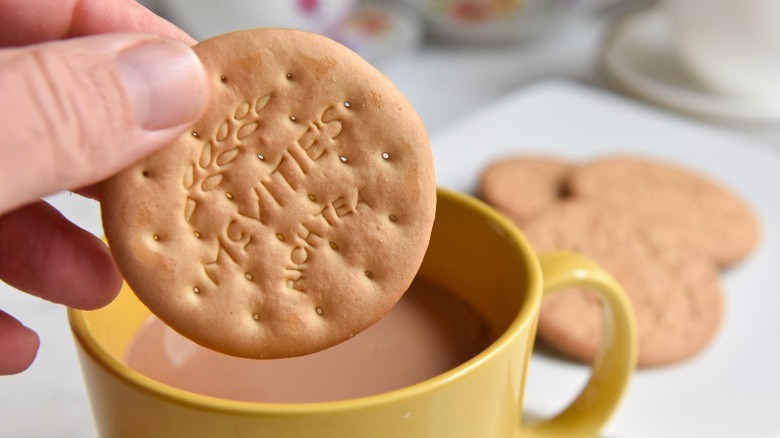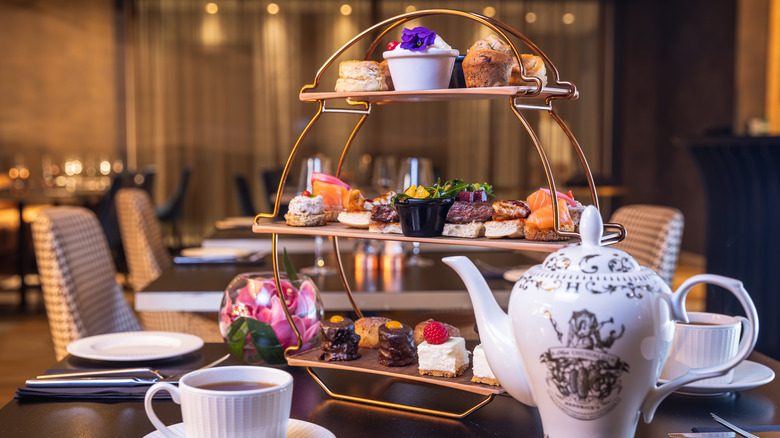What Tea Time In England Is Really Like
What's quite possibly more British than using the word "poppycock?" Partaking in an afternoon tea sitting. The British take their tea quite seriously and anyone who doesn't drink it the proper way, even if that's the Grammy-award winning singer Adele, will be chastised for it. In her hit music video "Hello," Adele is shown pouring hot water into her cup first, before placing the teabag in afterward. This miffed some of her fans, including British ones who called to #BoycottAdele, all becaues she wasn't preparing her tea the "proper" way (via Indy100). Turns out, the teabag always goes in first, at least according to some folks. Though it took six years for Adele to clarify that she wasn't the one who had brewed the tea in the video, the world had already learned a big lesson — tea is a lot more than just another beverage in England.
Afternoon tea complete with sandwiches, scones, and some leisurely gossip, hasn't changed much over the years, per Culturally Ours. If anything, its popularity has spiked, says The Guardian, with celebrities like Jodie Foster, Quentin Tarantino and fashion designer Alexander McQueen seen sipping several cups of it. But the myriad treats, fragile saucers, and delicate doilies can seem a tad intimidating for someone who has no idea how to respond to "Shall I be mother?" (they want to pour you some tea, not adopt you) — which is why we have here the deets about England's tea time that even "Downton Abbey" didn't show you.
Tea is had several times a day
While some of us simply stare at our phones when feeling socially awkward, those in England apparently make haste to their kitchen and brew some tea. As Kate Fox, author "Watching the English", told the BBC, "Tea-making is the perfect displacement activity: whenever the English feel awkward or uncomfortable in a social situation (that is, almost all the time), they make tea." In England, some have tea as many as seven times, as mentioned in Culturally Ours. Turns out, a day is punctuated with several cups of the stuff — from before 10 am to as late as 10 pm! Even the Ritz hotel in Piccadilly, London, offers five tea settings between 11.30 am and 7.30 pm (via The Guardian).
While some of us are used to hitting a Nespresso button for some quick caffeine, tea is not just a beverage that you swig before you start typing away at that email on your keyboard. Rather, it is meant to be a way to hit the brakes and enjoy some gossip with some scones. As the story goes, Catherine of Braganza, the Portuguese wife of Charles II who is believed to have brought tea to England in the 1600s, insisted that the couple have tea every day at 5 pm as a way to spend some quality time with her otherwise busy royal husband (via BBC).
The way you have your tea says a lot about you
If your entire tea-drinking experience only includes hollering for an iced chai latte at a Starbucks drive-thru window, you are probably blissfully unaware of how tea marks class. Indeed, the simple act of sipping the beverage can potentially be used to judge your annual income. Turns out, it's not just the sodden leaves at the bottom of your cup that say a lot about you, it's also the way you take the beverage. Milk or no milk? One, two, or more cubes of sugar? Each choice has a corresponding meaning. Research by The Grocer revealed that those who added more sugar to their tea happened to earn less income than those who preferred no sugar. Also, if you added milk first to your cup, it traditionally gave away that you were not well-to-do, according to the BBC.
According to Queen Elizabeth's butler, Grant Harrold, pouring milk before tea was something that people who couldn't afford good drinkware did (via Hello!). That's supposedly because hot tea could crack a cup that was not high quality china. Besides, those who belonged to the working class drank strong black tea, whereas the high society folks used weaker brews for a midday pick me up. Since the strong tea was too intense to be sipped all by itself, it was usually made into a sugary milky concoction called Builder's Tea (via BBC).
There is a proper way to brew your tea
Brewing your tea takes a little more work than tossing a tea bag into a microwaved cup of hot water. First of all, suggests Tom Parker Bowles, author of "The Cook Book", loose tea leaves are always better for brewing a good cuppa (via The Washington Post). Now, though the first step of brewing tea seems like it is common knowledge: boiling water in a kettle. Yet, one might get stuck with follow-up decisions such as how many spoons of tea leaves to add. Fortnum and Mason, an upmarket London department store, recommends adding one rounded teaspoon of tea leaves per person for traditional black tea. The leaves have to be left seeping in a teapot filled with water that's just off the boil. They must sit there for about three to five minutes before being poured into cups.
According to Bowles, most teas are brewed for four to five minutes, except for green teas which just need three minutes or less. Per Dr Stuart Farrimond, an expert in the science of tea making, notes that the cup that you drink your tea in also affects the taste. For example, a styrofoam cup effectively absorbs flavor compounds, making the tea less tasty than if it were served in less porous porcelain (via BBC). The color of the cup has a role to play as well. A red cup tricks our brain into finding the tea sweeter than it is, Farrimond says.
Usually, a variety of teas are offered
If you are hosting an afternoon tea party for your friends, do not stinge on the choice of teas. According to BBC Good Food, you'll ideally offer a range of options including herbal teas, fruit-flavored ones, chai, peppermint, English breakfast, or the Queen's favorite, Earl Grey. To beat the heat in summer, the BBC recommends serving a cpd iced tea, perhaps with a dash of Pimm's, a gin-based beverage. But is alcohol with tea the done thing? Turns out, it's actually not that uncommon.
The Ritz hotel in London actually has a Champagne tea sitting at 7.30 pm as part of its menu (via The Guardian). Likewise, the Bloomsbury Hotel serves Champagne and cocktails such as Islay Martini for its afternoon tea. Plenty of other hotels famed for fancy sit-down teas, such as the Dorchester, the Savoy, the Wolseley, and more all give their customers the option to add a bottle of Champagne to their afternoon tea time — at an extra charge, of course (via CNN Traveller).
It's not necessary to hold your pinkie out
A common perplexity that you might face as soon as you sit down for that first sip concerns your fingers. Namely, should you raise that pinkie up or keep it curled in? Turning the pages of history reveals that the pinkie-lifting habit was once a necessity to hold the handle-less cups that came from China to Europe. As the story goes, one had to wrap their fingers around the cup with the pinkie out for support (via Twinings). Also, since the tea was usually very hot, the drinkers naturally tried to limit the number of fingers coming in contact with the cup, thereby launching the pinkie out trend (via Chicago Tribune).
Though the cups started appearing with handles by 1810 (via Press Republican), the habit never quite went away. And since it was the rich who could afford the tea or the cups anyway, the habit came to be associated with high class society, per the Chicago Tribune.
Yet another explanation for the pinkie lift goes way back to ancient Rome wherein the affluent ate with only three fingers, pinkie excluded. Poor folks used all five (via Brooklyn Reporter). The little pinkie kept the society divided, but with time, it has found its place with the rest of the fingers, supporting the cup from the bottom. In fact, if you hold it up, like the aristocrats of the past did, you'll come off as rude, per etiquette expert Emily Post.
There is a right way to stir your cup of tea
If you haven't guessed already, tea time in England requires you to follow certain rules. What tops the list of "never-to-do" faux pas is stirring your tea in a manner that causes splashing and clinking. The BBC suggests moving the spoon back and forth in the cup in a "6-12-6-12 motion" (referring to the numerals on a clock, of course). This way is more elegant than a vigorous round and round motion with a spoon. The sugar apparently dissolves better this way, too.
Now, when it comes to actually drinking the beverage, there is a separate list of don't. There's certainly no slurping (via Emily Post. Do not pick up the saucer along with the cup (unless there's no table in front of you) and no wrapping the cup with your hands (via Town and Country). Furthermore, don't place the cup outside of the saucer, while looking elsewhere but the cup while sipping is an absolute no. Never place the napkin on the chair — its proper place is to the left of your teacup (via Twinings).
Phew! Feels like a lot, you say? It probably is, for, even the Duchess of Sussex, Meghan Markle — that would be the wife of Prince Harry, Queen Elizabeth's grandson. Meghan had to do quite a bit of homework before sitting for a tea session with the Queen, reports Food & Wine.
Tea is always accompanied by snacks
Like the entourage of people around the Queen, an array of snacks always accompanies the tea pot. As per Culturally Ours, these treats can include sandwiches, cookies, scones, and more. Unless it's high tea (which is actually just another term for dinner), where the offerings include a spread that is a tad heavier. That includes things like cold cuts, cheeses, and pies, as per Bruce Richardson, author of "A Social History of Tea" (via NPR). High tea, ironically, was more often had by lower classes who skipped lunch, and dove straight for dinner after work, he says. For this, they sat at their dining table with high chairs, contrary to the low armchairs that were used by high society ladies for their afternoon tea or "low tea."
There is a specific person to whom the popularity of afternoon tea can be attributed to: the Duchess of Bedford, Anna Maria Russell. Back in the 1830s, two meals a day was the norm, with one taking place at noon and the other around 7.30 pm. But Russell, quite understandably, couldn't stand the long break between the two meals, and decided to take a tea break in private. The one-off event became a habit, with her friends eventually joining in. Thanks to Russell, an afternoon tea is now part of a day's routine in England, and it includes a delectable set of snacks, which, per Richardson, must be eaten with restraint — no matter how ravenous you are.
Scones are a tea time must
Can you imagine burgers without fries? Bagels without cream cheese? Thanksgiving without cranberry sauce? Well, scones and tea have the same interdependence. According to Shael Mead, head pastry chef at Ham Yard Hotel in London, scones complete an afternoon tea. Yet, if the sight of a scone has you reaching for a knife, we'll have to politely ask you to put that silverware down (via The Washington Post). Scones are not meant to be sliced into two neat halves, but gently broken into two pieces with your hands, per William Hanson, etiquette expert (via BBC). You needn't worry, as a well-made scone won't reduce into a puddle of crumbles at the slightest pressure. An ideal scone is not flaky, but is closer in texture to an American biscuit: crusty on the outside and soft on the inside.
Breaking open the scone is not the end of it, though, as there is a proper way to eat it. Scones are served with jam and clotted cream. According to Hanson, you won't be looked at weirdly based on which spread you reach out for first, unless you are dining in the southwest region of England. Those diners in places like Cornwall spread the jam first and cream second (just like the Queen does), but those from the neighboring region of Devon insist that the cream goes on the scone before the jam. Either way, just remember to never wash it down with a cuppa (via Twinings).
Cake is always kept for last
It's completely natural to feel the pull towards the best-looking dessert on the table, but tea drinking in England also seems to be a test of one's restraint. So, don't fail it by grabbing a slice of a sponge cake as soon as you lay the napkin down in your lap. That's because cakes come at the very end of a tea session. As per etiquette expert William Hanson, the right order of consumable is sandwiches first, then scones, and finally, cakes or pastries (via BBC). In a private house, you can even predict which cake you might be served based on the season in which you're dining. In the summer, it's Victoria sponge, which is made of two fluffy sponge cakes stuck together with a layer of whipped cream, jam, or vanilla cream. In the winter, the high class cake served would be a fruit cake loaded with candied fruit, spices, and nuts.
That said, no one would stop you if you want to make it a little grand. As per head pastry chef of Ham Yard Hotel in London, Shael Mead, every tea sitting could use a showstopper. Mead suggests a classic British treat known as a Battenberg cake, a checkered sponge cake wrapped in marzipan (via The Washington Post). Thankfully, there are no hard and fast rules around eating a cake at tea. You can even use your hands if you want to, per Hanson, or simply a fork.
Dunking your biscuits in tea is not always okay
Tea and biscuits go exceedingly well together. It's not just the satisfaction of seeing your crispy biscuit soften inside a cup of warm tea, either. Dunking a cookie in tea does in fact spike the taste of it, per celebrity British chef Heston Blumenthal. With the help of a device developed by food scientists from the University of Nottingham, Blumenthal learned that a chocolate-covered biscuit dunked in tea released more flavor as opposed to a dry one (via NPR).
Dr. Len Fisher noted that Swiss scientists found the flavor of a dunked cookie to be enhanced by about 10 times compared to an un-dunked one (via Nature). Fisher also arrived at the ideal dunking period: 3.5 to 5 seconds, per his blog.
Despite all these efforts to understand the science of dunking biscuits, it turns out that the act itself is not considered appropriate all the time. According to Twinings, dunking biscuits in tea makes for bad table manners, According to research from British snack food brand McVitie's, one in five Brits consider it inappropriate to do so at work (via Independent).
Presentation matters
If you are hosting a tea party, now is the time to fetch that forgotten set of crockery from the back of the shelves. Afternoon tea is not just about brewing a perfect Earl Grey, but creating an ambiance that has your guests using the word 'loo' instead of 'bathroom', like the royals do.
To set the mood, BBC Good Food recommends using the best set of crockery you have, and a tiered cake stand that you probably kept away thinking it's a bit much. Shael Mead, head pastry chef at Ham Yard Hotel in London, suggests a more "vintage-chic" approach that includes using a collection of tea cups and plates that may not all belong to the same set. Go ahead and boldy pair that floral-patterned cup with a plate that has bumble bee design on it, because the random mix and match helps recreate the environment of tea places in England (via The Washington Post).
Besides a neat table cloth, napkins, cutlery, and silverware, if you want to up the ante, you can even hang some bunting on the walls, or up it even further by making those buntings out of edible biscuits, recommends BBC Good Food.
